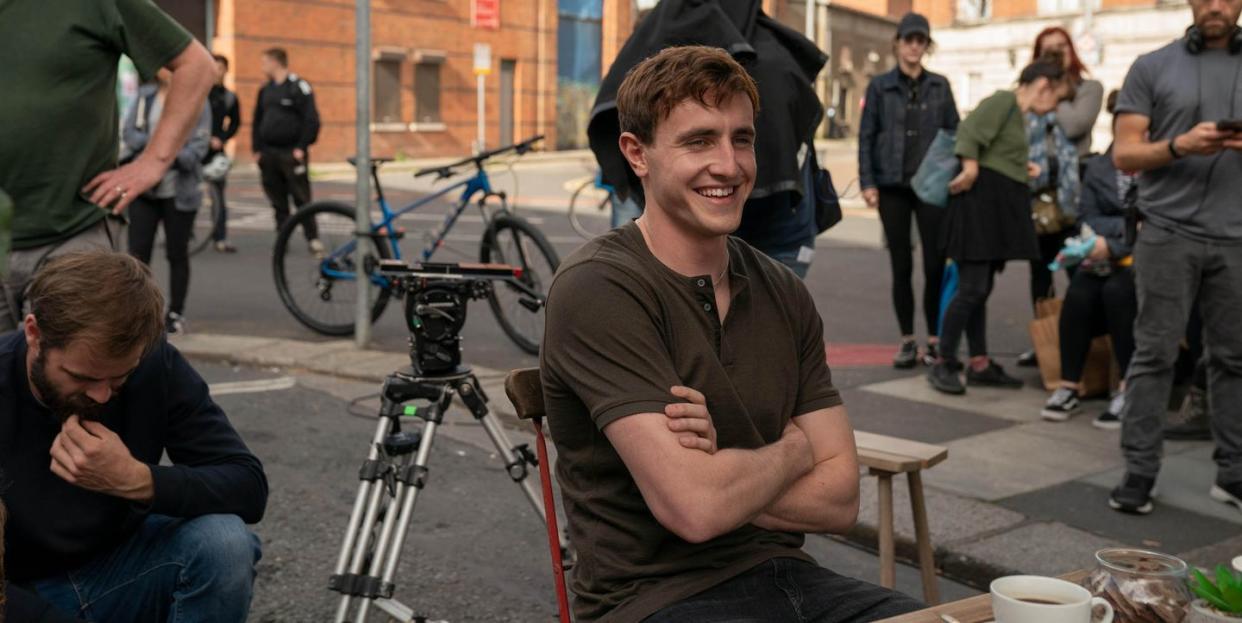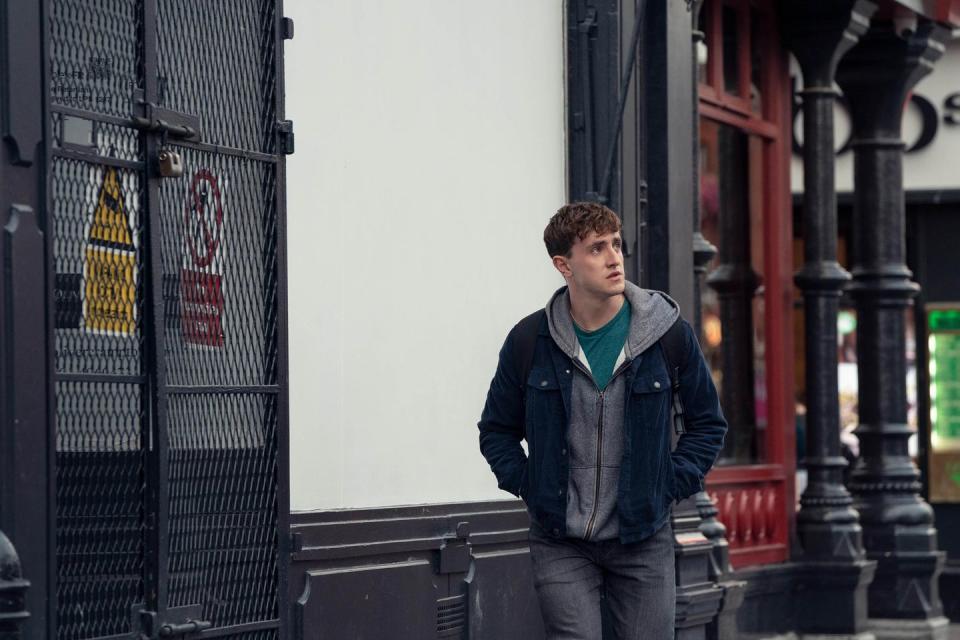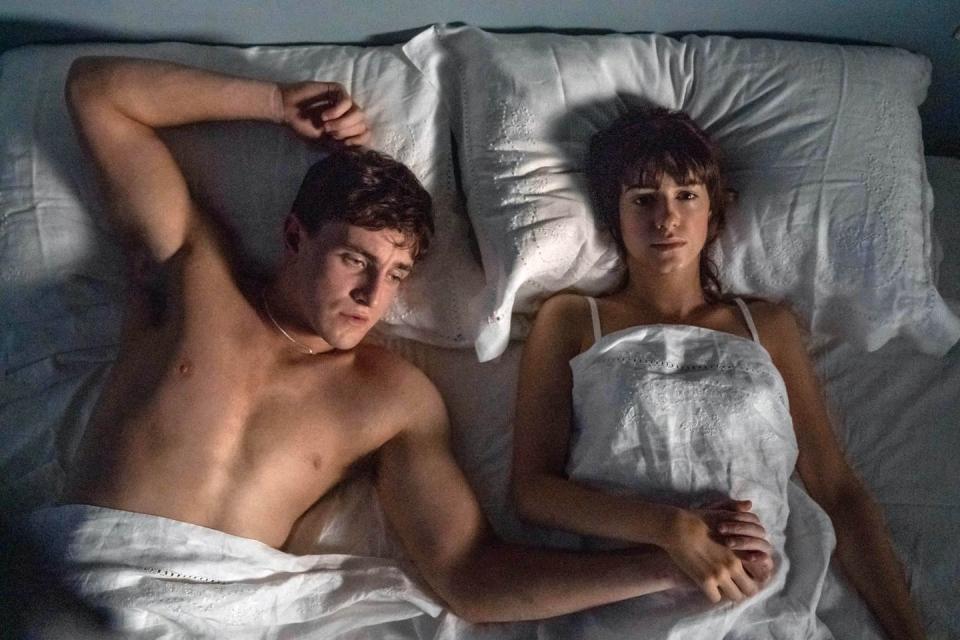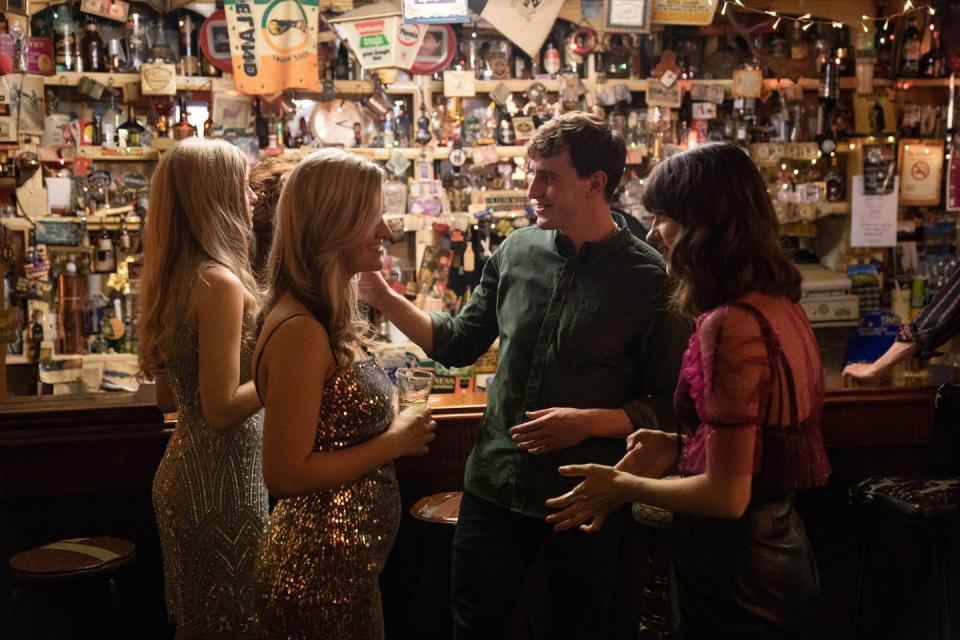'Normal People' Star Paul Mescal Is Doing Everything He Can Not to Ruin Connell for You

Oh no. The Christmas sweater.
Marianne and Connell are losing it. Or Daisy and Paul. They’re definitely Daisy and Paul in this moment. It's September, and they're in the home stretch of filming the TV adaptation of Sally Rooney’s Normal People. The director, Hettie Macdonald, has been telling Daisy Edgar-Jones to be more Marianne and less Daisy all day. Paul Mescal is just as guilty.
The scene: Marianne is at Connell’s house for Christmas. She’s just finished changing. Maybe a cry, too—it’s probably the first Christmas when she’s felt surrounded by people who love her, maybe ever. It’s one of Rooney’s signature sweet-sad moments in the novel: Connell walks in, wearing an ugly Christmas sweater, asks if it’s too much, and Marianne goes, “No. It’s so nice. A proper Christmas. It’s lovely.”
Now, in a warehouse about 20 minutes outside of Dublin, Marianne’s tugging on the last arm of her sweater. Door opens. It’s a giant snowman. On the sweater. Big white snowflake polka-dots around him. Way too much. Marianne disappears, Daisy’s back, they erupt in a laughing fit, cut. They go through this three, four, maybe five times. When you get to the episode, actually, you’ll see Daisy’s face is still tied in that about-to-lose-it knot.
"I think it’s been such such fun," says Mescal about working with Edgar-Jones. "When you find out your castmates, maybe the next thing you jump to is like, I hope to god I have a strong chemistry with this person." We'll get to that.
About two years ago, Irish author Sally Rooney debuted her second novel, Normal People, which followed two Irish teenagers, Connell Waldron and Marianne Sheridan, as they fall in and out of each other’s lives from high school until the end of college. It made Rooney a literary star, Connell and Marianne stand-ins for millennial love (and anxiety), loading the inevitable adaptation—which debuts on BBC and Hulu this Wednesday—with all the pressure that comes with having to translate a literary hit to the screen. Its success, of course, will live and die with its leads: Paul Mescal and Daisy Edgar-Jones. Daisy's used to TV by now—this isn't even her first book-to-screen role. Mescal? It's one of his first times acting in front of a camera, period.

But you wouldn't know it, seeing him behind the scenes. Mescal is a little like the prom king of the Normal People set, always joking around, keeping the mood from going full Sufjan. Are you allowed to have that much fun when you’re playing Connell Waldron, the tongue-tied, cloudy-headed, millennial Stephen Daedalus? Just two years ago, the 24-year-old was graduating from Trinity College. Now, he’s bringing a beloved character to life—one who was just about entirely portrayed via inner monologue—for a show that fans will dissect like they’re sitting on a thesis defense panel. More so than usual, too, because a global pandemic has made Normal People’s premiere a literary-world Super Bowl.
But Mescal doesn’t know that yet. It’s September. So let him rib on Connell’s ugly Christmas sweater, okay?
When interview time comes, Mescal just finished filming what might be Connell’s darkest time in the book: The buildup to Rob’s funeral. No proper Christmas sweater. He’s wearing a black suit, still looking a little morose, but happy to see you, halfway between Connell and Paul. Tall, square jaw, brown mess of hair. Alternates between speaking quippy one-liners and scenic-route paragraphs. They share a lot, actually.
“There were like four or five of us [during the Normal People auditions] like, Wow, I can really see myself in this character. And I think it’s the same for the way women see Marianne as well,” Mescal says.
You don’t get many Connell Waldrons in something as popular as Normal People. It isn’t exactly a role made for that little highlight reel they play at the Emmys when they announce the nominees. These are the types of fictional men we see on screen these days: Beefcake superheroes (Cap!). Sadboys (Miles, from Hulu’s last TV adaptation of young love, Looking for Alaska). Overtly toxic, beyond redemption (Barry Berkman, Don Draper, Walter White). Hard to relate to! If you do, you’re probably either watching 500 Days of Summer on repeat, or just, you know, should take a long look at yourself.

Connell can kick a football around. Read a book, like, not for school. Attractive, but not in a way where an entire Dublin bar would be trying to catch his eye. He’s a repressed, confused-as hell ex-jock, a loner who makes almost no friends in college—so he doesn’t have anyone to talk to besides Marianne, really—and is usually found silent, nose-deep in a book, hidden somewhere in Trinity’s library. Throughout much of the story he's grieving, depressed, and isn't sure what to do about it—a situation we don't see play out on screen nearly enough, especially for young, college-aged men, many of whom are at risk for the self-harm we read about in the novel.
Going into Normal People, it probably helps that Mescal had a sort of Troy Bolton situation growing up, aside from sharing an alma mater with Connell. Although, if you spend two minutes with him, you’ll get that he’s achieved several more levels of social aptitude than his Rooney doppelgänger. Still, they’re not all that different. Both have a knack for Gaelic football. (You can find write-ups about his career in Kildare if you look hard enough.) On the artsy side, Mescal pursued a BA in acting at the Lir Academy, played Jay Gatsby in a theater production of the Fitzgerald classic. He also starred in an adaptation of The Red Shoes at a big-time theater. But nothing like Normal People.
“Sometimes, if I think about it too much you feel the pressure of, Oh god I have to do this amazing character justice for the audience that’s going to see it, so it does add a certain pressure,” he says.

Something that probably added to that pressure (or took away from it, maybe): Casting Mescal as Connell was about the surest thing of Normal People’s pre-production, from the producers’ perspectives. Funny, because Paul has been described with about a thousand plucked-from-obscurity, relative-unknown clichés, while Edgar-Jones was just finishing a leading role in a War of the Worlds TV adaptation as she was auditioning for Marianne.
“I suppose the funny thing with Connell is when we started casting we saw a poll and we all went, Well that’s Connell,” says Emma Norton, one of the show’s producers. “It was one of the most crucial moments of this process. I was sitting at my desk, and I watched Paul, and I was like, Oh my God. Oh my God.”
The star power might not be obvious to you at first. Probably not a few episodes in, even. In the novel, Mescal says, you’re reading Marianne and Connell’s thoughts, understanding each nuance of every interaction they have—that’s part of the book's greatness. In the TV adaptation, it’s the two of them not being in the same frame at the same time. The camera lingering on Connell until you start to feel uncomfortable. The directors would even give Daisy and Paul differing notes without the other one hearing.

When Mescal finally lets it all out—you can count those moments on one hand—you’ll see why, in a production that’s been just about as delicate and pitch-perfect as Rooney in every decision, they cast him virtually on sight. Mescal nails Connell’s antsy wallflower energy. Always simmering, always thinking. When he has to talk—whether it’s a stilted What you mean? or something that will literally decide the fate of the next half year of his relationship with Marianne—the words plunk out of his mouth like he couldn’t give less of a shit, his eyes registering self-hate, how desperate he was to get it right.
But don't let that fool you for lack of chemistry with Edgar-Jones. The story goes: When Daisy and Paul read together for the first time as Marianne and Connell, the producers started crying. They launched out of their seats to hug Daisy. Afterward, one of the directors, Room’s Lenny Abrahamson, had to tell them to work on their poker faces. “You understand why it’s called a chemistry reading,” says Catherine Magee, one of the hugging producers. “We knew immediately. Immediately. That’s it. We have it.”
Yeah. The chemistry better be there. Have you read the book? Don’t watch Normal People thinking you’re getting YA adaptation-level flirting. From a scale of John Green to HBO, it’s Mescal going full frontal. Dude looks like he’s about to drool watching Marianne shake it at the Debs. They make out to Carly Rae Jepsen! The sweaty, popsicles-and-a-soccer-game afternoon—you know the scene—registers at about a 17 compared to the novel. You buy the sex.
“He’s the best—it’s been brilliant, we’re like the best friends,” says Edgar-Jones about Mescal. “I feel like he makes me a better actor, working with him, which is really amazing. Because he’s a star.”
Now, on the brink of Normal People's debut, Mescal is checking all those early-fame boxes: Blue Twitter check, slowly, but surely growing Wikipedia bio, signed to a big agency. But, again, September, a world ago, none of that. He’s talking about the feeling of getting to know people over a four-month-long shoot, filming beyond-intimate scenes with someone you’ve become so close to. “I feel like a different human being now,” he says.
Back on set, in Connell’s makeshift bedroom, surrounded by the lights, and the cameras, and the small team of producers trying to convert Rooney’s magic over to the moving image, Paul can’t even get past “Is this too—.” Macdonald seems a little annoyed now. Annoyed in a kids will be kids way. They take a break to cool off. Maybe he’ll change.
Paul walks off the set, head down, lips pursed. He’s holding back a smile.
You Might Also Like

